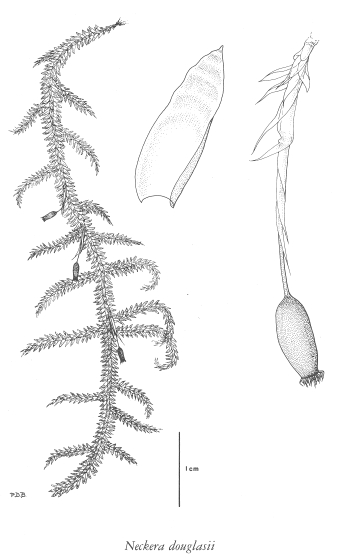Neckera douglasii Hook.
Douglas' neckera
Neckeraceae
Species Account Author: Wilf Schofield
Extracted from Some Common Mosses of BC
Introduction to the Bryophytes of BC
Douglas' neckera
Neckeraceae
Species Account Author: Wilf Schofield
Extracted from Some Common Mosses of BC
Introduction to the Bryophytes of BC
Species Information
Species description:
Genus named in honour of N.J. de Necker, an 18th-century German botanist. Species named in honour of David Douglas, a well known, 19th-century Scottish plant explorer of western North America.
Comments:
This species is sometimes extremely abundant in humid coastal forests where it festoons tree branches and sheathes trunks of small trees and shrubs.
Distinguishing characteristics:
The usually soft, glossy, yellow-green, flattened shoots with undulate leaves and shining, relatively regular pinnate branching serve as useful features, especially when sporophytes are present.
Habit:
Pale yellow-green, regularly to irregularly branched flattened shoots, hanging down on perpendicular sites and pendent on horizontal sites, sometimes forming dense mats.
Similar Species:
Notes under Metaneckera menziesii. : Neckera pennata plants are similar in some respects but the leaves are glossy, while those of Metaneckera are somewhat dull; N. pennata also lacks fragile slender branchlets. N. doug/asii also lacks the branchlets and tends to be pale yellow-green with sporophytes on a conspicuous elongate seta, unlike the short seta of N. pennata and Metaneckera. Species of Plagiothecium are all irregularly branched, produce sporophytes on an elongate seta that emerges on the upper side of the shoot, and lack brittle lateral branchlets.
Illustration

If more than one illustration is available for a species (e.g., separate illustrations were provided for two subspecies) then links to the separate images will be provided below. Note that individual subspecies or varietal illustrations are not always available.
Illustration Source: Some Common Mosses of BC
Habitat and Range
Habitat
Most commonly epiphytic on trunks and branches of living trees in open coniferous or broad-leafed forests, also on cliffs and rocks. Reproduction: Sporophytes occasional to locally abundant, pale redbrown and hanging downward from the underside of the leafy shoot. Range
World DistributionConfined to western North America from southeastern Alaska to California and extending eastward to western Montana.